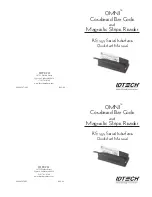
1
OBDII EOBD &
CAN Code Reader
User Guide
1. Safety precautions and warnings
To prevent personal injury or damage to vehicle and/or the
scan tool, read this instruction manual first and observe
the following safety precautions whenever working on a
vehicle:
1. Always perform testing in a safe working environment
2. Keep clothing, hair, hands, tools, test equipment, etc. away from all
moving or hot engine parts
3. Operate the vehicle in a well ventilated work area
4. Put the vehicle in ‘Park’ for automatic or ‘Neutral’ for manual
transmission and apply parking brake
302200
5. Never leave the vehicle unattended
6. Use extreme caution when working around the ignition coil, distributor
cap, ignition wires and spark plugs. These components create
hazardous voltages when the engine is running
8. Keep a fire extinguisher on hand suitable for petrol/chemical and
electrical fires
9. Don’t connect or disconnect any test equipment while the ignition is on
or the engine is running
10. Keep the scan tool dry, clean, free from oil/water or grease. Use a
mild detergent on a clean cloth to clean the outside of the scan tool
when necessary
1
Safety precautions and warnings
1
2
General information
2
2.1
On-Board Diagnostics (OBD) II
2
2.2
Diagnostic Trouble Codes (DTCs)
2
2.3
Location of the Data Link Connector (DLC) 2
2.4
OBD II readiness monitors
2
2.5
OBD II monitor readiness status
2
2.6
OBD II definitions
3
2.7
OBD II modes of operation
3
3
Using the scan tool
4
3.1
Tool description
4
3.2 Specifications
4
3.3
Navigation characters
4
3.4 Keyboard
4
3.5
Power supply
4
3.6
Tool setup
4
3.7 About
5
3.8
Vehicle coverage
5
4
OBDII diagnostics
6
4.1
Read codes
6
4.2
Erase codes
6
4.3
Data stream
7
4.4
View freeze frame
7
4.5
I/M Readiness
8
4.6
Vehicle info
8
4.7
Exiting the OBDII test
8
5
I/M Readiness
8
5.1
Ready test mode
8
5.2
Scan tool mode
9
6
Product troubleshooting
9
Table of contents
Page



























